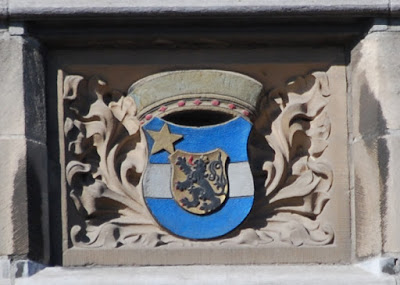It is, as you can see, a very impressive building! But, as usual, it was the heraldry across its face (and, as it turns out, around its side) that really caught my eye.
For example, here's a closer view of the three coats of arms across the frieze above.
You can, as always, click on the image to see a larger version with more detail.
From left to right, we find the arms of:
From left to right, we find the arms of:
the town of Sint-Niklaas in the province of East Flanders: Azure figure of a bishop between in dexter base three children in a tub and in sinister a turnip or;
what, as far as we have been able to determine (because they are not correctly depicted here), are the arms of the Congo Free State, later the Belgian Congo, mis-painted here as: Azure a fess argent in dexter chief a mullet or overall an inescutcheon Or a lion rampant sable crowned or (Flanders). The fess on the arms of the should be wavy, and inescutcheon should be the arms of Belgium, not Flanders (e.g., Sable a lion rampant or).
The city of Erpent, in Namur province, has a similar shield, theirs being Azure a fess and in dexter chief a mullet or, thus having the fess (the horizontal band) being gold instead of white, and without the inescutcheon of Belgium or Flanders. And finally, we have:
the city of Leuven, in the province of Flemish Brabant: Gules a fess argent. (Yes, I know that most of us will also recognize this shield as the arms of Austria. Trust me, here they are the arms of Leuven.)
Next time, how to armorially decorate your balcony, Belgian-style.















No comments:
Post a Comment